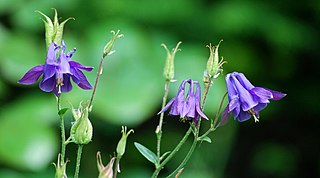
Aquilegia is a genus of about 130 species of perennial plants that are found in meadows, woodlands, and at higher elevations throughout the Northern Hemisphere, known for the spurred petals of their flowers.

Aquilegia formosa, the crimson columbine, western columbine, or (ambiguously) "red columbine", is a common wildflower native to western North America, from Alaska to Baja California, and eastward to Montana and Wyoming.

Aquilegia canadensis, the Canadian or Canada columbine, eastern red columbine, or wild columbine, is a species of flowering plant in the buttercup family Ranunculaceae. It is an herbaceous perennial native to woodland and rocky slopes in eastern North America, prized for its red and yellow flowers. It readily hybridizes with other species in the genus Aquilegia.
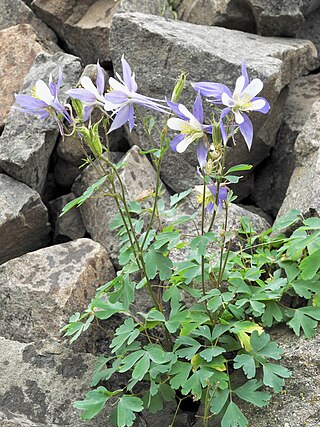
Aquilegia coerulea, the Colorado columbine, Rocky Mountain columbine, or blue columbine, is a species of flowering plant in the buttercup family Ranunculaceae, native to the Rocky Mountains and some of the surrounding states of the western United States. It is the state flower of Colorado. The Latin specific name coerulea means "sky blue".
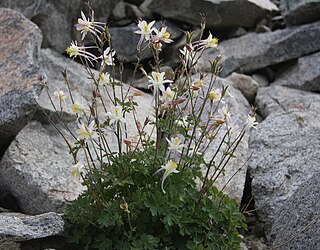
Aquilegia pubescens is a perennial flowering plant in the family Ranunculaceae, endemic to the Sierra Nevada in California. It is usually known by the common name Sierra columbine, and less frequently as the alpine columbine or Coville's columbine.

Aquilegia chrysantha, the golden columbine, is a perennial herbaceous flowering plant native to the southwestern United States and northwestern Mexico. The plant, with a height of between 40 centimetres (16 in) and 120 centimetres (47 in), has yellow flowers. A. chrysantha. as with other members of the Aquilegia coerulea species complex, is evolved for pollination by hawkmoth. It favors moist environments in its mountainous range.

Aquilegia eximia, the serpentine columbine or Van Houtte's columbine, is a perennial species of flowering plant in the family Ranunculaceae, endemic to California.

Symphyotrichum pilosum is a perennial, herbaceous, flowering plant in the Asteraceae family native to central and eastern North America. It is commonly called hairy white oldfield aster, frost aster, white heath aster, heath aster, hairy aster, common old field aster, old field aster, awl aster, nailrod, and steelweed. There are two varieties: Symphyotrichumpilosum var.pilosum, known by the common names previously listed, and Symphyotrichumpilosum var.pringlei, known as Pringle's aster. Both varieties are conservationally secure globally and in most provinces and states where they are native.
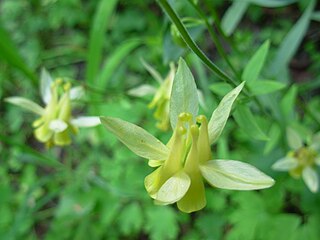
Aquilegia flavescens, the yellow columbine, is a perennial species of flowering plant in the family Ranunculaceae, native to the Rocky Mountains of the United States and Canada.

Aquilegia micrantha var. grahamii, common name Graham's columbine, is a variety of perennial flowering plant in the family Ranunculaceae, endemic to Utah in the United States.

Aquilegia longissima, the long-spur columbine or long-spurred columbine, is a rare perennial flowering plant in the family Ranunculaceae that is native to northern Mexico, Texas, and Arizona.

Aquilegia hinckleyana, or Hinckley's golden columbine, is a partially recognized species of flowering plant of the genus Aquilegia (columbines) in the family Ranunculaceae endemic to Capote Falls in northwestern Presidio County, Texas. The plant is found within a small region of the county and only grows in moister areas of its generally dry range. Considered a smaller version of Aquilegia chrysantha, A. hinckleyana has a height of around 60 centimetres (24 in) and possesses yellow flowers. It has seen modern cultivation, particularly in Texas. The species is named for L. C. Hinckley, who first collected the species in 1943.
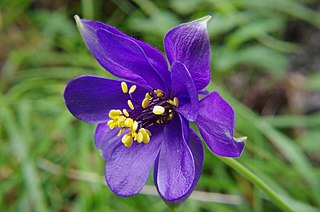
Aquilegia alpina, often called the alpine columbine or breath of God, is a perennial species of flowering plant in the family Ranunculaceae, native to the western and central Alps. Though rare in its Swiss, Austrian, and Italian range, it is commonly found in the French Maritime Alps. A. alpina is appreciated for its light blue to blue-purple flowers.

Aquilegia viridiflora, commonly known as the green columbine or green-flowered columbine, is a perennial flowering plant in the family Ranunculaceae, native to southern Siberia, northern China, Mongolia, and Japan.

Aquilegia sibirica, the Siberian columbine, is a species of flowering plant in the family Ranunculaceae native to the north-central Asian regions of Siberia, northern Mongolia, Kazakhstan, and Xinjiang. A hardy perennial plant, it prefers temperate environments. The Siberian columbine can be between 1 foot (0.30 m) and 2 feet (0.61 m) tall with flowers that are lilac-blue and white in color.

Aquilegia glandulosa, the Altai columbine or Siberian columbine, is a perennial species of flowering plant in the family Ranunculaceae, native to northern and central Asia.

Aquilegia micrantha, the Mancos columbine or Bluff City columbine, is a perennial species of plant in the family Ranunculaceae, native to Utah, Colorado, and Arizona.

Aquilegia chaplinei, also known as Chaplin's columbine, is a species of flowering plant in the family Ranunculaceae native to the arid Guadalupe and Sacramento Mountains of West Texas and southeastern New Mexico in the West South Central United States. A perennial plant with an average height of 40 centimeters (16 in), A. chaplinei is characterized as a dwarf version of its close relative Aquilegia chrysantha and is sometimes considered a variant of this species under the name Aquilegia chrysantha var. chaplinei.

Aquilegia fosteri, common name Foster's columbine, is a perennial flowering plant in the family Ranunculaceae, native to Utah and Arizona.
Aquilegia holmgrenii, common name Noel's columbine, is a perennial flowering plant in the family Ranunculaceae, endemic to Utah.



















